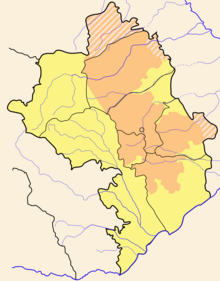Territórios controlados pelos armênios em torno do Alto Carabaque
Aspeto

Os territórios controlados pelos armênios em torno do Alto Carabaque eram áreas que formalmente faz parte do Azerbaijão e estavam situadas fora do antigo Oblast Autónomo do Alto Carabaque, que estiveram sob controle das forças militares da Armênia e de Artsaque desde o fim da Guerra do Alto Carabaque em 1994, até o novo conflito de 2020.[1][2][3][4][5]
Descrição
[editar | editar código-fonte]Com base na divisão administrativa e territorial do Azerbaijão, as forças armênias controlavam os territórios dos seguintes municípios do Azerbaijão:[6]
- Kelbajar - (1,936 km2,[7] 100% do território era controlada pelo Exército de Defesa de Artsaque),
- Lachin - (1,835 km2.[7] - 100%),
- Qubadli - (802 km2.[7] - 100%),
- Jabrayil - (1,050 km2.[7] - 100%),
- Zangilan - (707 km2.[7] - 100%),
- Agdam - (1,094 km2.[7] - 77% (842 km2)),
- Fizuli - (1,386 km2.[7] - 33% - 462 km2.)
A área total do território era de 7 634 km2. O perímetro exterior desses territórios era uma linha de contato direto entre as forças militares de Artsaque e do Azerbaijão.[8]
Referências
- ↑ Нужны ли российские миротворцы в Нагорном Карабахе (em russo)
- ↑ Human Rights Watch. Playing the "Communal Card". Communal Violence and Human Rights. ("By early 1992 full-scale fighting broke out between Nagorno-Karabakh Armenians and Azerbaijani authorities.") / ("...Karabakh Armenian forces -often with the support of forces from the Republic of Armenia- conducted large-scale operations...") / ("Because 1993 witnessed unrelenting Karabakh Armenian offensives against the Azerbaijani provinces surrounding Nagorno-Karabakh...") / ("Since late 1993, the conflict has also clearly become internationalized: in addition to Azerbaijani and Karabakh Armenian forces, troops from the Republic of Armenia participate on the Karabakh side in fighting inside Azerbaijan and in Nagorno-Karabakh.")
- ↑ Human Rights Watch. The former Soviet Union. Human Rights Developments. ("In 1992 the conflict grew far more lethal as both sides -the Azerbaijani National Army and free-lance militias fighting along with it, and ethnic Armenians and mercenaries fighting in the Popular Liberation Army of Artsakh- began...")
- ↑ United States Institute of Peace. Nagorno-Karabakh Searching for a Solution. Foreword. Arquivado em 2 de dezembro de 2008, no Wayback Machine. ("Nagorno-Karabakh’s armed forces have not only fortified their region, but have also occupied a large swath of surrounding Azeri territory in the hopes of linking the enclave to Armenia.")
- ↑ United States Institute of Peace. Sovereignty after Empire. Self-Determination Movements in the Former Soviet Union. Hopes and Disappointments: Case Studies. Arquivado em 11 de junho de 2009, no Wayback Machine. ("Meanwhile, the conflict over Nagorno-Karabakh was gradually transforming into a full-scale war between Azeri and Karabakh irregulars, the latter receiving support from Armenia.") / ("Azerbaijan's objective advantage in terms of human and economic potential has so far been offset by the superior fighting skills and discipline of Nagorno-Karabakh's forces. After a series of offensives, retreats, and counteroffensives, Nagorno-Karabakh now controls a sizable portion of Azerbaijan proper (...), including the Lachin corridor.")
- ↑ Адекватному пониманию армяно-азербайджанского конфликта мешает распространение и повторение ложной статистики (em russo)
- ↑ a b c d e f g Азербайджанская ССР - Административно-территориальное деление (em russo). Baku: Azgoisdat (Азгоиздат). 1979
- ↑ Вооруженное противостояние на Южном Кавказе (em russo)
